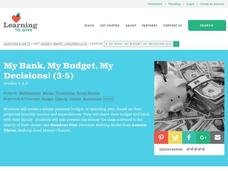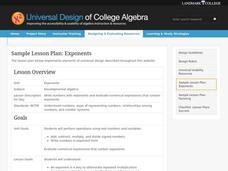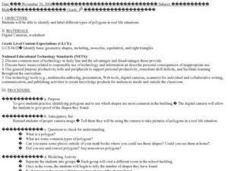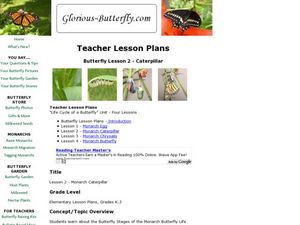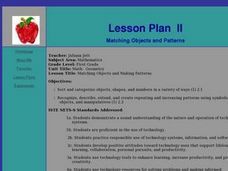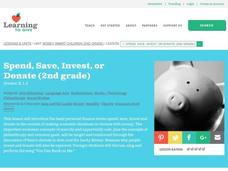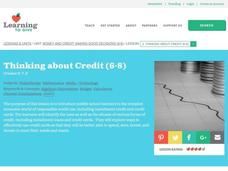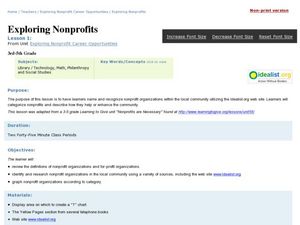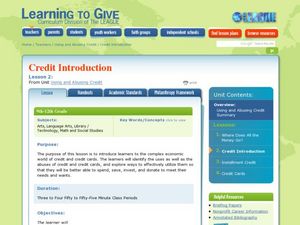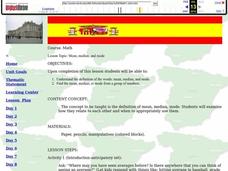Curated OER
My Bank, My Budget, My Decisions!
Young scholars build a budget. In this philanthropy lesson, students write a personal budget that includes spending, saving, investing, and donating. Student philanthropists donate money to charities.
Curated OER
Triangles
In this geometry worksheet, 10th graders solve problems involving triangular inequality. They apply the proofs and theorem of triangles to solve these problems. There is an overview and one question.
Curated OER
Exponents
Ninth graders solve problems involving exponential functions. In this algebra lesson plan, 9th graders apply their knowledge of exponential properties to add, multiply, divide and subtract exponential functions. They perform these...
Curated OER
Factoring
Ninth graders factor equations and find prime numbers. In this algebra lesson, 9th graders find the factors and prime factors of a number using multiples and relatively prime numbers.
Curated OER
Inch By Inch
Students explore the concept of measuring length using a one-inch pipe cleaner "inchworm." They listen to the story "Inch By Inch by Leo Lionni and discuss how the animals were measured by the inchworm in the book. In pairs students...
Curated OER
Spaghetti Graphs
Students work in pairs to test the strength of spaghetti strands. They collect and graph data to determine a line of best fit. Students create a linear equation to interpret their data. Based on the data collected, students predict...
Curated OER
Polygons in Real Life
Fourth graders identify and label different types of polygons in real life situations. Using a digital camera, they take pictures of polygons on the school grounds, tally the number of shapes found, and answer discussion questions.
Curated OER
Geometry Poetry
Students write an original diamante poem about a shape of their choice. They examine how to write a diamante poem, and select a shape and write a poem using Microsoft Word software.
Curated OER
Introductory Lesson on Multiplication
Third graders investigate the role of addition in mathematics by participating in this role play. The teacher dresses up like a squirrel and chooses students to dress as baby squirrels. The class uses multiplication to determine the...
Curated OER
Butterfly Lesson 2 - Monarch Caterpillar
Students study the Monarch Butterfly life cycle. In this Monarch Butterfly lesson, students examine what happens prior to a caterpillar hatching, how often it sheds its skin, and what the caterpillar goes through when it is...
Curated OER
The Amazing Heart
Students examine human blood flow by comparing the pulse of athletes. In this human body lesson, students discover the equation for finding the cardiac output from a human heart. Students identify heart rates of accomplished...
Curated OER
Matching Objects and Patterns
First graders participate in hands-on activities and use objects to create patterns. They observe a PowerPoint lesson describing matching objects and patterns. In groups, 1st graders complete geometry computer activities such as planting...
Curated OER
Buzzing is BEE-lieving
Young scholars investigate insects. In this insect lesson, students explore various insect models and identify the characteristics of each. Young scholars observe insects outside and tally how many insects they observe.
Curated OER
Purchasing Power
Young scholars participate in a lemonade sale and record their sales in a journal. In this fundraising instructional activity, students donate money they have raised from a lemonade sale and make a plan for how the money should be spent.
Curated OER
Money Smart children
Learners elementary financial vocabulary words: spend, save, invest and donate. In this finance lesson, students respond to the story "Sam and the Lucky Moon." Learners describe the concepts of wants and needs, resources, scarcity,...
Curated OER
Measure It Up!
Students investigate the states that water may take. In this physical science lesson, students read the book, Water: Up, Down, and All Around and recall the states of water from the book. Students examine how water takes the shape of its...
Curated OER
Digging for Dirt
Learners examine how trash is removed and evaluate statistics related to trash removal. In this trash removal lesson, students explore the different methods of trash removal and make an original diagram graphing statistical information....
Curated OER
Thinking About Credit
Students examine the use of credit such as installment purchases and credit cards. In this credit lesson, students learn the vocabulary associated with credit usage such as mortgage, credit report/score, and debit cards. They determine...
Curated OER
Non Profits Are Necessary
Learners discuss the importance of nonprofit organizations. In this nonprofit instructional activity, students research nonprofit organizations online and study the nonprofits' impact on society.
Curated OER
Banking on Family
Students examine the meaning of a trust bank account. For this financial awareness lesson, students brainstorm ways they are trustworthy to their family and define the meaning of a trust bank account.
Curated OER
Credit Interview
Student determine a safe debt load. In this credit interview activity, students explore the importance of budgeting, saving and investing. They examine the pros and cons of using a credit card. Students discuss how to build credit, apply...
Curated OER
Making Good Money Choices
High schoolers determine how to spend donated money. In this money choices lesson, students explore the needs of the community. They determine the best use of donated funds for a good cause or charity. High schoolers play a bingo game to...
Curated OER
Mean Median and Mode
Young scholars collect data, graph it and analyze it. In this statistics lesson plan, students plot their data and calculate the mean, median and mode explaining how it relates to the data. They define the ways to find the mean, median...
Curated OER
Large Number Concept
Eighth graders compare objects to large numbers. In this algebra instructional activity, 8th graders compare large numbers to daily objects. Relate large numbers to the real world by discussing the Holocaust and the number of people who...


